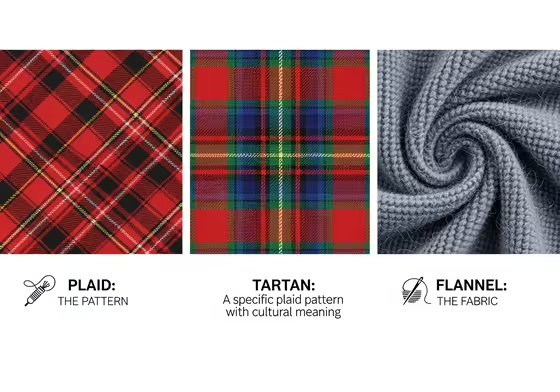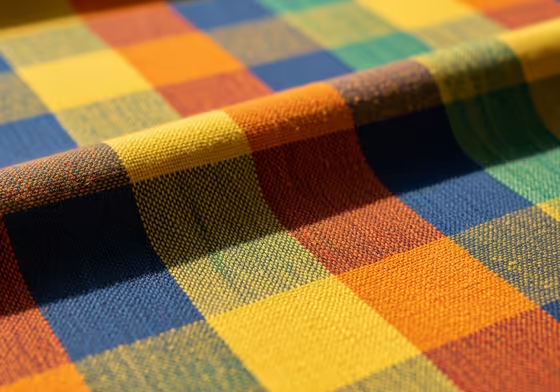A Simple Guide to Plaid and Its History
Plaid is a simple pattern that has a complicated story. It's been worn by Scottish kings, 90s rock bands, and almost everyone in between. Plaid can mean rebellion to one person and tradition to another.
The pattern has been around for about 3,000 years. It was found on ancient mummies in China and was once a forbidden symbol in Scotland. Later, the same British monarchy that banned it started wearing it.

Plaid then came to America and became the look for lumberjacks. It was also picked up by punk rockers and preppy students.
But to really get plaid, you have to start with its name. Most people get the name wrong. Let's clear up some of the confusion.
Plaid, Tartan, or Flannel?
Before we get into the history, let's clear up the words. People often mix up "plaid," "tartan," and "flannel." They actually mean three different things.

The Word "Plaid" Actually Means Blanket
Many people think "plaid" is the name of a pattern, but it's not. The word comes from the Scottish Gaelic word plaide , which means "blanket." It was first written down in the early 1500s.
The first plaid was a big piece of heavy wool cloth. People in the Scottish Highlands used it for everything. They would belt it to make a kilt and drape the rest over their shoulder for a cloak.
At night, they would use this same piece of cloth as a warm blanket. Over time, people outside of Scotland, especially in America , started calling the pattern on the blanket "plaid."
In Scotland, the Pattern Is Called "Tartan"
If you're in Scotland, don't call the pattern "plaid." The right word for the pattern is "tartan." In Scotland, a "plaid" still means a blanket or a piece of clothing worn over the shoulder.
The mix-up is mostly an American thing. When Scottish immigrants came to America, they brought their wool blankets, or plaide. Americans started calling the pattern "plaid" after the name of the blanket.
In America, the pattern was just a design. It wasn't connected to Scottish family history or pride. So, the word "plaid" stuck.
How to Say "Plaid" the Right Way
Most people in America pronounce plaid to rhyme with "played." But the original Scottish pronunciation is different. It's actually said as "plad," to rhyme with "add."
This is because the word comes from Gaelic, where the "ai" sound is a short 'a'. So, even though it's spelled with "ai," the sound is "a." The word for blanket in Ukrainian is even similar, it's pronounced pled .
Plaid's Journey Through History
Now that we know the right words, we can look at the pattern's long history. The story starts in Central Asia, not Scotland. It later became a big deal in the Scottish Highlands and then spread across the world.
Plaid Is Really, Really Old
We think of plaid as Scottish, but the oldest examples were found far away in western China. These pieces of cloth were discovered with ancient mummies preserved in the desert .

One famous mummy, called the "Cherchen Man," died around 1000 BC. This means his plaid-like clothing is about 3,000 years old. He was wearing a tunic and leggings with a colorful, striped pattern.
This discovery shows that tartan wasn't just a Scottish thing. It was a type of weaving used by ancient Celtic people across Europe and Asia. The Scottish tartan tradition is just the most famous version that survived.
Plaid Was Once Against the Law
Tartan was the everyday clothing for people in the Scottish Highlands. Different patterns represented different families or clans. Because of this, the pattern became a political symbol.
In 1745, Scottish clans tried to put a new king on the British throne. They lost, and the British government wanted to crush their culture. So, they passed the Dress Act of 1746 .
This law made it illegal for men and boys in the Highlands to wear tartan or kilts. The goal was to take away their identity and stop another rebellion. The ban lasted for 36 years.
But the ban didn't work as planned. It made tartan even more important to Scottish identity. The pattern became a powerful symbol of defiance.
How Plaid Came to America
When Scottish immigrants came to America, they brought tartan with them. But in America, the pattern wasn't about family clans. It became popular because it was useful for workers on the frontier.
A company called Woolrich started making wool shirts in Pennsylvania in 1830. In 1850, they made a red-and-black plaid shirt that became famous as the "Buffalo Check." It's still a classic American pattern today.

Another company, Pendleton Woolen Mills , started making colorful plaid shirts for men in 1924. This helped turn the plaid shirt from work clothes into something people wore for fun.
Plaid Shirts Meant Different Things to Different People
In America, the plaid shirt came to mean different things. It could be seen on a hardworking lumberjack, a rebellious musician, or a wealthy college student.

First, it was the uniform for lumberjacks and farmers. Flannel was warm and tough , and the plaid pattern was great at hiding dirt. This gave the shirt a rugged, outdoorsy image.
Then, in the 1990s, grunge bands from Seattle like Nirvana and Pearl Jam started wearing plaid flannel shirts. They wore them because they were cheap and practical, which was a statement against flashy fashion. This made plaid a symbol of anti-fashion and rebellion .
At the same time, plaid was a key part of the "preppy" style on the East Coast. Wealthy students wore plaid skirts, blazers, and lightweight shirts. For them, plaid represented tradition and a classic American look.
What Different Plaids Mean
In Scotland, a tartan is more than just a pattern. It's a way to show who you are and where you come from. While many rules have relaxed, some traditions are still around.
Are There Rules for Wearing Tartan?
Many people wonder if they're "allowed" to wear a certain tartan. The good news is that most of the time, there are no rules. Wearing a tartan that isn't your family's is usually seen as a sign of respect.
There are only a few "private" tartans that have rules. The most famous is the Balmoral tartan, which is the personal pattern of the British royal family. It was designed by Prince Albert, and only the royals and their personal piper can wear it .
But most tartans are "universal," meaning anyone can wear them. Some popular universal tartans include:

- Black Watch: A dark blue and green pattern that was originally for a military regiment. Since it's not tied to one family, it's open for anyone to wear .
- Hunting Stewart: A green tartan that is traditionally open to everyone.
- Scotland Forever: A modern tartan made for people who don't have a specific Scottish family connection.
The World's Most Famous Plaid
The most famous and most produced tartan in the world is the Royal Stewart Tartan. It has a bright red background and is the personal tartan of the British monarch. It's connected to the royal House of Stewart.
Technically, you're supposed to have the monarch's permission to wear it. But the pattern became too popular to restrict. It's now considered a universal tartan that anyone can wear.

In the 1970s, this royal pattern was adopted by the punk rock movement. Punks wore the Queen's personal tartan torn and held together with safety pins. It was a way to rebel against the government and tradition.
Madras: A Plaid From India
One of the most popular plaid patterns has nothing to do with Scotland. Madras is a lightweight cotton fabric that comes from the city of Madras, India. It's designed for hot and humid weather.

Real Madras plaid is hand-woven and has a unique texture. The pattern is the same on both sides of the fabric. It was originally made with natural dyes that would "bleed" when washed.
This bleeding created a soft, faded look that people loved. An advertising campaign in the 1950s even used the tagline "Guaranteed to Bleed" to sell the fabric. Madras became a staple of American "preppy" style.
Plaid in Everyday Life
Besides its long history, plaid is a part of modern life for two simple reasons. It's useful and it makes us feel comfortable.
Why We See Plaid at Christmas
Every winter, plaid shows up everywhere on wrapping paper, pajamas, and decorations. There's a reason we connect plaid with the holidays. It mostly has to do with feeling cozy.

Plaid, especially on soft flannel, just looks warm and comfortable. It reminds people of a cozy cabin in the woods, which fits the holiday spirit. This tradition was made popular by Queen Victoria and Prince Albert.
They loved both Christmas and all things Scottish. They famously decorated their Balmoral Castle with lots of tartan. Because the royal family were huge trendsetters, people began to associate tartan with their cozy, festive Christmas celebrations.
Why Farmers and Lumberjacks Wear Plaid
The classic image of a lumberjack in a plaid shirt isn't about fashion. It's all about function. The real hero here is the flannel fabric, not the plaid pattern.
Flannel is great for outdoor work because it's warm, durable, and comfortable. The fabric has a fuzzy texture that traps heat to keep you warm. It's also tough enough to handle hard labor.
The plaid pattern was the perfect match for flannel. The busy, colorful design is great at hiding dirt, mud, and sawdust. A plaid flannel shirt was the perfect uniform for anyone working outdoors.
Plaid vs. Flannel: What's the Difference?
This is the most common mix-up in the world of clothes. Many people use "plaid" and "flannel" to mean the same thing. But they are completely different.
- Plaid is a pattern. It's the design with intersecting stripes that you see. You can have a plaid pattern on any kind of fabric, like cotton, silk, or wool.
- Flannel is a fabric. It's the soft, warm material that feels fuzzy. Flannel can come in a plaid pattern, or it can be a solid color.
The two got mixed up because the plaid flannel shirt is so popular. But you can have a plaid shirt that isn't flannel. And you can have a flannel shirt that isn't plaid.
So, What's the Big Deal With Plaid?
Plaid has a long and interesting history packed into its simple squares. It started as an ancient weaving style found in China. It then became the symbol of Scottish families and their identity.
The pattern was once banned in Scotland, which only made it more iconic. It was worn by British royalty, which then made it a target for punk rockers to rebel against.
In America, plaid became the look of the hardworking lumberjack and the anti-fashion grunge scene. It has been used to show tradition, rebellion, work, and comfort. Plaid is a pattern that has meant something different to everyone who has worn it.